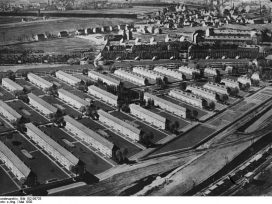Spatial planning found itself in crisis in the mid-1990s. Due to the problems caused by globalization, and ineffective solutions to them, there was even talk of the death of urbanism in the modern age. Cities all over the world sprawled uncontrollably across the natural landscape, eventually exceeding traditional models and becoming sprawling urbanized regions, densely covered with imprints of human development, erasing not only the boundary between the built environment and the natural environment but also between the city centre and its edge. The business and residential functions of the old centres have been taken over by towns on the periphery, reducing and devaluing their original significance. At the same time radical changes in the post-industrial and information society have had an impact on the transformation of cities.
New social forms of residence (non-family) and new lifestyles (more mobile) and work styles (self-employment, self-organization) have appeared. The rapid development of information and communication technologies has (of course with the ongoing support of the capitalist system) produced an abstract space devoted to the flow of information which intersects with physical space and forms an integral part of the modern city.
Urbanism is now at a crossroad. Urban theory and practice need to be radically redefined, as well as their roles and meaning have to be redefined: established methods of urban planning in today’s time of rapid and unpredictable change have turned out to be completely ineffective and are unable to keep pace with social processes in the real world. In Europe as well as elsewhere around the world, new methods for guiding and controlling spatial development are taking shape. They are not based solely on a determination of the physical structure of cities but rather bring together diverse planning strategies aimed at supporting sustainable goals: a search for balance among all the elements of urban life.
The concept of the sustainable city as a long-term development prospect is diametrically opposed to short-term profit-motivated spatial interventions and (in the narrower sense of the topic treated here) includes the renewal of city centres, revitalization of urban areas, creation of a high quality environment for residents from different social groups, the minimalization of land use, mixed use of the urban space, environmentally friendly transportation and the protection of the natural and cultural heritage in cities. At the forefront (along with globalization) are local values; genius loci, contextualism, and construction on a human scale are emphasized.
The main purpose behind this thematic issue of Dialogi was to provide an analysis of the current situation in particular Slovenian cities which during the time of economic transition succumbed to the dissemination of a market-based concept of space. Slovenian city centres, due to their smaller size, cannot be compared to cities on a world scale, but they nevertheless display the essential characteristics of the modern city such as a division between the historical centre and the edge which is draining the vitality out of the old city centre. However, the articles by nine authors, architects, and urban planners are not limited just to the problem of revitalizing urban space in city centres, they also illuminate other negative spatial impacts and problems in urban planning which the profession has been facing in a time of radical social transformation, and offer new ideas and visions for the effective solving of these problems in future.
The first in the collection of articles by experts is a paper by Peter Fister, who specializes in the conservation of the cultural heritage and in the renewal of settlements which are protected as national monuments. He calls attention to the importance of so-called “open planning”, whose main tenet is the creation of a specific living environment involving collaboration with residents and users. The author stresses that only an interdisciplinary approach which takes into account the standards of residents themselves can ensure a high quality living environment, and notes that in Slovenia this new method of urban planning, despite formal acceptance of the innovations it brings, is still not fully established.
That an approach which includes residents in the planning process brings positive results and contributes to a rise in building culture is demonstrated by Ziva Deu, a specialist in the renewal of the autochthonous architectural heritage and its conservation, in an article about the integrated revitalization of Upper Stanjel, an important monument of immovable cultural heritage. In the past this village was known not only for its architectural and spatial qualities, but also for the unsuccessful attempts to revitalize it. The author gives particular attention to three spatial and implementation documents which are based on the principles of sustainable development and new international guidelines for the integrated conservation of building heritage. They have become a model for architectural and urban planning developments of this kind, and as models of quality professional solutions they are also reflected in legislation.
Next are three articles by authors who critically assess conditions in three Slovenian cities. Sonja Ifko analyzes the reasons for the inadequate revitalization of the Lent area in Maribor, which due to the deficient management of public programs and poor economic conditions has not fully gotten underway. She stresses that in order to revitalize the city’s waterfront, it is essential to take steps to preserve retail activities in the city centre, especially now as new development projects in the city are being prepared.
Bostjan Bugarich also finds that the main reason for the substantive and consequently social void in the city centre of Koper is the growth of a city of consumption, which is gradually obscuring the view of the historic city. The incomplete organization of the urban space is entirely subordinated to political interests and economic investments that make it impossible to develop a range of activities essential for the revitalization of life in the old centre, as well as for the preservation of the architectural heritage. He sees the solution in the active inclusion of the public in spatial planning processes and in the locating of university activities in the declining urban fabric which would contribute to social and physical renewal.
In the third article, Adrijan Cingerle looks at the creation of Nova Gorica, a border town regarded both as a large-scale “Yugoslav political achievement” and a failed experiment of modernism in architectural and urban planning. The original plan for the “City of Roses”, as designed by Edvard Ravnikar, was realized only in fragments. Cingerle believes that the modest heritage of the modern is a highly valued tradition and could by means of well planned projects be effectively built upon into a distinctive architectural and urban whole. Unfortunately, neither the professionals at the municipality nor local politicians have a clear developmental vision that could open up possibilities for connecting the city with the neighbouring Italian city of Gorizia into a new centre for a broader European region.
The common denominator for the next set of articles are new strategies for the development of city centres based on sustainable principles and possibilities offered by modern information.
Ilka Cherpes describes the experimental project Europan 9 – Expanded city centre Poljane, which has provided not only specific solutions for the transformation of the Poljane neighbourhood into a new city centre of Ljubljana, but also general guidelines for the elaboration of sustainable urban planning and architectural plans. In addition, city authorities, based on an analysis of proposed solutions, have abandoned the idea of an expansion of the University Clinical Centre into this part of the city since a homogenous hospital complex would be in conflict with the idea of creating a new city centre as well as with the goals of sustainable development.
Polona Filipich and Primoz Hochevar analyze infills – innovative architectural solutions in selected urban voids in Maribor and Celje, which are evaluated as important interventions for ensuring sustainable development in city centres. Because infills are based on the judicious use of degraded plots of land which already have infrastructure, they ensure an economic urban renewal, encourage revitalization, and contribute to a rise in the quality of life and importance of city centres.
Alma Zavodnik Lamovsek, who does research on regional development and polycentric urban networks, looks at the influence of modern information and communication technology on the development of city centres. The hypothesis that the opportunities offered by new technology are an important factor in successful renewal is tested in a case study of Idrija, a town with a valuable technological and cultural heritage but which is remote from larger urban centres. Her research shows that the town has created its own unique image and successfully connected itself with the world using information and communication technologies that will contribute to the effective development of the old city centre also in the future.
Peter Gabrijelchich presents the multifold results of selected international student workshops on urban planning and architecture, with the help of which the profession is also shaping responses to specific questions in the search for spatial solutions. Proposals that represent a kind of foundation for continuing discussions in the profession are especially beneficial in cases where constructive dialogue between various actors in the process of preparing spatial documentation has been broken off.
We conclude that up until now we have been witnessing more or less short term interventions in city centres that in no way follow the dynamics of contemporary age. They also attest to an improvement of conditions, since the profession has a range of potential, sustainably oriented ideas available that (in some places) have already brought specific results. But purely theoretical knowledge and professional efforts will certainly not be sufficient for the effective direction of the development of city centres. A clear understanding of the rapid social and spatial changes of the contemporary age will need to be acquired also by those who work in municipal agencies, by local politicians, and eventually also the wider public.
The issue was developed in cooperation with Alenka Fikfak, with whom we present and introductory interview about current issues relating to the revitalization of city centres, and who invited experts from two Ljubljana faculties (the Faculty of Architecture and the Faculty of Civil Engineering and Geodetic Science) to participate, and directed and coordinated their efforts.






